60TH Anniversary of the deaths of Lt Patrick Riordan and Pte Andrew Wickham on 16 Dec 1961 during the Battle of the Tunnel.
The is the third and final article to cover the deaths in combat of 36 Inf Bn personnel in Elisabethville in Dec 1961. Compiled by George Kerton PRO IUNVA.
Operation Unokat commenced on 5 Dec 1961 and continued up to 20 Dec. Up to 14 Dec, 1 Bde and 2 Bde concentrated their operations on attempting to keep open routes from their camps and HQ Katanga Comd to the airport to keep this lifeline open. Between 9 and 15 Dec, the incoming 36 Inf Bn was involved mainly in defensive operations to secure its positions at Prince Leopold Farm and Rousseau Farm. This was conducted under sustained mortar and small arms fire from the Gendarmerie from fortified positions mainly from Camp Massart and the Union Minière du Haut-Katanga (UMHK) mining company compound as well as from other locations. By 14 Dec, ONUC had built up its strength in Elisabethville to around 4,500.
On 16 Dec, 2 Bde was tasked to take the area around the Lido and the industrial buildings nearby as well as the UMHK compound and to secure the main route to the airport. One of the 2 Bde units, the Indian 3/1 Gurkha Bn was tasked with securing the northern approaches to the Tunnel and then to seize and control the main road from the city centre to the airport (Route Alpha) thereby protecting the right flank of 36 Inf Bn.
The composite Swedish Bn (with elements of 12 Bn and the incoming 14 Bn) was tasked with the main attack to seize and hold Camp Massart.
36 Inf Bn had to secure the right flank of the Swedish Bn, by seizing and holding the area of the road network Kasenga/Luxembourg and, on order, to seize and hold the Tunnel after the capture of the area of the road network.
B Coy had to take the road network known as Triangle GFD Chaussée de Kasenga – Avenue des Savoniers – Avenue Luxembourg and after this objective had been secured, A Coy was to seize and hold the Tunnel on order. C Coy was Bn reserve. 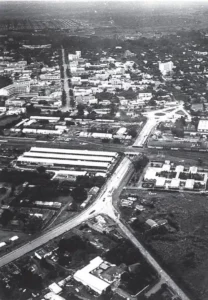 The Tunnel was an underpass under the railway line. Fire support was provided by the Bn’s own 81 mm Mors and a half Tp from the Indian 120 Hy Mor Bty and Swedish medium mors.
The Tunnel was an underpass under the railway line. Fire support was provided by the Bn’s own 81 mm Mors and a half Tp from the Indian 120 Hy Mor Bty and Swedish medium mors.
The remainder of 35 Inf Bn who were about to rotate home, (that is A Coy minus and the Armd Car Gp) were tasked with securing Charlie Route to the airport and White Piers Crossroads, they were not involved in the fighting at the Tunnel.
36 Inf Bn crossed the start line in darkness at 0400 hours, torrential rain had been falling for two hours. The Indian Hy Mors engaged Gendarmerie positions before the Bn crossed the start line.
The attached sketch map shows the plan of attack. B Coy had a section of two Ford armoured cars under command, Lt Tony Carr commanded the armoured vehicles. 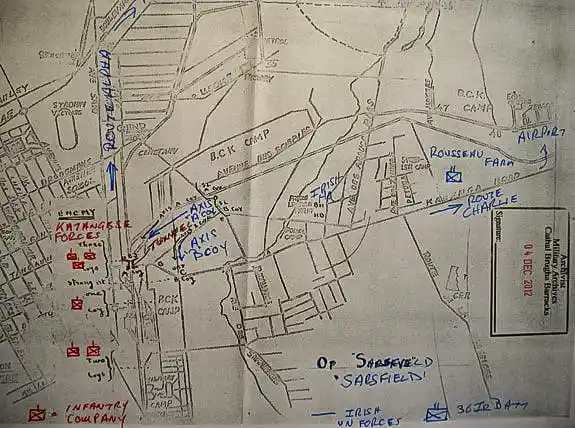 As B Coy advanced to take the road network, the lead Pl commanded by Lt Tommy Dunne was pinned down by HMG fire from the Tunnel and the road network. One Ford skidded of the track and was immobilised in the waterlogged terrain, Lt Carr moved his armoured car forward and he engaged both position with his Vickers MMG, he fired 360 rounds. The Bn Mors put down suppressive fire on the Gendarmerie positions and B Coy took their objective.
As B Coy advanced to take the road network, the lead Pl commanded by Lt Tommy Dunne was pinned down by HMG fire from the Tunnel and the road network. One Ford skidded of the track and was immobilised in the waterlogged terrain, Lt Carr moved his armoured car forward and he engaged both position with his Vickers MMG, he fired 360 rounds. The Bn Mors put down suppressive fire on the Gendarmerie positions and B Coy took their objective.
As A Coy advanced to take its objective, it encountered Gendarmerie dug in around the Tunnel and in railway carriages. 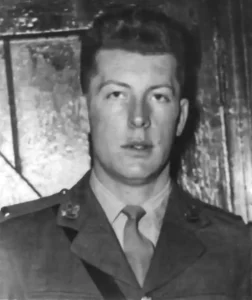 The advance faltered at 0545 hours as they were pinned down by Gendarmerie mors, these were neutralised by Irish and Indian Mors. As the advance continued, Lt Patrick Riordan, the Pl Comd 1 Pl, was killed by MG fire. A Coy put in a company-in-attack using 84 mm ant-tank recoilless rifles, energas and hand grenades against the railway carriages. As the fire fight continued, Pte Andrew Wickham, Rdo Op 1 Pl, was hit in a volley of fire.
The advance faltered at 0545 hours as they were pinned down by Gendarmerie mors, these were neutralised by Irish and Indian Mors. As the advance continued, Lt Patrick Riordan, the Pl Comd 1 Pl, was killed by MG fire. A Coy put in a company-in-attack using 84 mm ant-tank recoilless rifles, energas and hand grenades against the railway carriages. As the fire fight continued, Pte Andrew Wickham, Rdo Op 1 Pl, was hit in a volley of fire. 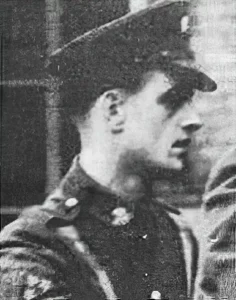 Cpl Charles Connolly, a medic, rendered first aid but Pte Wickham died from his wounds. The Tunnel was taken by A Coy before 0630 hours. It was later estimated that the Gendarmerie had deployed six companies in the Tunnel, in railway coaches, dug in on the tracks and sidings and around the railway station.
Cpl Charles Connolly, a medic, rendered first aid but Pte Wickham died from his wounds. The Tunnel was taken by A Coy before 0630 hours. It was later estimated that the Gendarmerie had deployed six companies in the Tunnel, in railway coaches, dug in on the tracks and sidings and around the railway station.
The Gendarmerie mounted counterattacks using mortars, HMGs and sniper, these were beaten off. On 17 Dec, the Ethiopian troops in the Lido area were still being subjected to heavy fire from the buildings of the UMHK, six Ethiopians were killed, ONUC aircraft hit the compound with rockets and MG fire. From 18 Dec, ONUC armoured patrols were mounted through the city streets to re-establish law and order.
By Tuesday 19 Dec, ONUC controlled the whole city, Tshombé escaped to Kipushi and he agreed to have talks with the central government.
On 20 Dec, the Acting Secretary General, U Thant declared that ONUC would observe a “hold fire”, that is, the UN would not initiate firing but would respond in kind to any firing from Katangese Forces. This was not a ceasefire and there was no signed agreement like the protocols that were agreed after Operation Morthar in Sep.
The Central Government, representatives of the Katanga authorities and ONUC met at Kitona Base and after difficult protracted negotiations agreement was reached at 0230 hours on 21 Dec. Tshombé accepted the application of the Loi fondamentale (the state law and constitution), he recognised the indissoluble unity of the Congo and Kasa-Vubu as Head of State; he recognised the authority of the Central Government over all parts of the Republic; agreed to the participation of Katangese representatives in the Governmental Commission to be convened at Leopoldville on 3 Jan 1962 for the purpose of studying the draft of the future constitution; pledged himself to enable deputies and senators from Katanga to discharge their national mandate from 27 Dec1961; agreed that the Katanga gendarmerie should be placed under the authority of the President of the Republic; and pledged himself to ensure respect for the resolutions of the General Assembly and the Security Council. On the surface it appeared that the secession of Katanga had been resolved but it was not, Tshombé was stalling.
Lt Patrick Anthony Riordan (25) was born in Cork city but he spent all his life in Dublin. He joined the Defence Forces as a Cdt with 29 Cadet Class, he was commissioned on 26 Nov 1956 and his home unit was 5 Inf Bn. He married his wife Eithne in May 1960 and they lived at College Crescent, Terenure, Dublin.
Pte Andrew Wickham (25) was from Clonard, Barntown, Co Wexford, he joined the Defence Forces less than six months before he deployed overseas. His parent unit was 2 Grn S&T Coy. He was survived by his wife, Eleanor, and six young children, Andrew (5), Garry (4), David (3), Deirdre (1 and a half) and Imelda (6 Months), their home was at Landen Rd Ballyfermot, Dublin. His brother, Cpl Richard Wickham, parent unit McKee Bks Coy had just returned from the Congo in Nov having served with 1 Inf Gp.
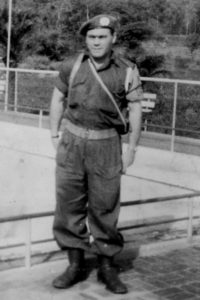 The funerals of Lt Paddy Riordan, Sgt Paddy Mulcahy and Pte Andy Wickham took place on 4 Jan 1962 and they were laid to rest in the Congo Plot, Glasnevin Cemetery.
The funerals of Lt Paddy Riordan, Sgt Paddy Mulcahy and Pte Andy Wickham took place on 4 Jan 1962 and they were laid to rest in the Congo Plot, Glasnevin Cemetery.
Lt Riordan was posthumously awarded the Distinguished Service Medal with Distinction, his citation reads:
“For distinguished service with the United Nations Force in the Republic of Congo, in displaying courage and leadership during the period of hostilities in December 1961. Lieutenant Riordan was tireless in his task in insuring the efficiency and welfare of his platoon under very trying circumstances, and it was while actually leading his platoon in an attack that he met his death”.
![]()
